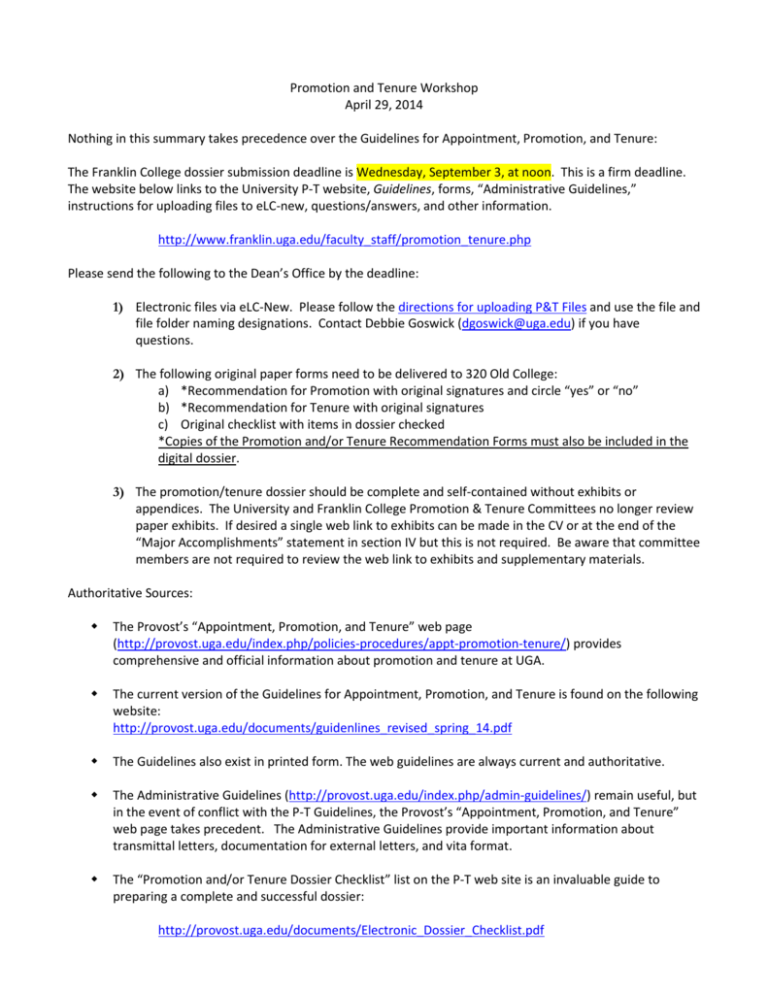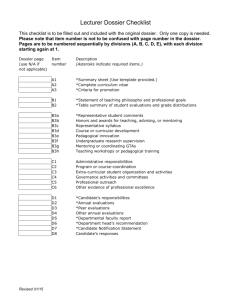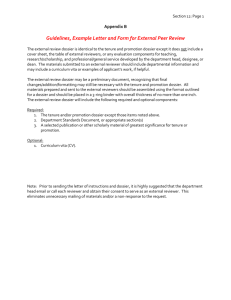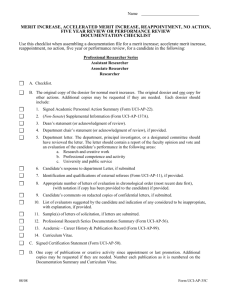Submission deadline:
advertisement

Promotion and Tenure Workshop April 29, 2014 Nothing in this summary takes precedence over the Guidelines for Appointment, Promotion, and Tenure: The Franklin College dossier submission deadline is Wednesday, September 3, at noon. This is a firm deadline. The website below links to the University P-T website, Guidelines, forms, “Administrative Guidelines,” instructions for uploading files to eLC-new, questions/answers, and other information. http://www.franklin.uga.edu/faculty_staff/promotion_tenure.php Please send the following to the Dean’s Office by the deadline: 1) Electronic files via eLC-New. Please follow the directions for uploading P&T Files and use the file and file folder naming designations. Contact Debbie Goswick (dgoswick@uga.edu) if you have questions. 2) The following original paper forms need to be delivered to 320 Old College: a) *Recommendation for Promotion with original signatures and circle “yes” or “no” b) *Recommendation for Tenure with original signatures c) Original checklist with items in dossier checked *Copies of the Promotion and/or Tenure Recommendation Forms must also be included in the digital dossier. 3) The promotion/tenure dossier should be complete and self-contained without exhibits or appendices. The University and Franklin College Promotion & Tenure Committees no longer review paper exhibits. If desired a single web link to exhibits can be made in the CV or at the end of the “Major Accomplishments” statement in section IV but this is not required. Be aware that committee members are not required to review the web link to exhibits and supplementary materials. Authoritative Sources: The Provost’s “Appointment, Promotion, and Tenure” web page (http://provost.uga.edu/index.php/policies-procedures/appt-promotion-tenure/) provides comprehensive and official information about promotion and tenure at UGA. The current version of the Guidelines for Appointment, Promotion, and Tenure is found on the following website: http://provost.uga.edu/documents/guidenlines_revised_spring_14.pdf The Guidelines also exist in printed form. The web guidelines are always current and authoritative. The Administrative Guidelines (http://provost.uga.edu/index.php/admin-guidelines/) remain useful, but in the event of conflict with the P-T Guidelines, the Provost’s “Appointment, Promotion, and Tenure” web page takes precedent. The Administrative Guidelines provide important information about transmittal letters, documentation for external letters, and vita format. The “Promotion and/or Tenure Dossier Checklist” list on the P-T web site is an invaluable guide to preparing a complete and successful dossier: http://provost.uga.edu/documents/Electronic_Dossier_Checklist.pdf Promotion Guidelines Please see instructions for uploading the nine sections of the dossier for each candidate. The nine sections are the nine items listed on the checklist. Each candidate will have a folder with nine files. Items should follow in the checklist order below: 1. Letter of Transmittal (example) 2. Table of Contents (example); no page numbering needed 3. Section I – Forms Use Quick Reference to calculate years in rank, years at UGA UGA Recommendation for Promotion Form UGA Recommendation for Tenure Form (if applicable) Reminders: Please do not use administrative titles Use total years teaching university/college-level courses for academic credit (not just UGA) In the “Recommend” section to the right of the vote: Be sure to circle Yes or No 4. Section II – Cover Letters The cover letter evaluates the overall quality of the candidate’s contributions to the promotion unit, the University, state, and discipline. It presents and summarizes the argument for promotion or tenure Separate cover letters for tenure (Appendix E) and promotion (Appendix F) Include the date of the departmental vote and state whether a quorum was present in both letters Clarify the role played by the candidate in joint publications Address weaknesses (split votes, negative letters) Explain why promotion or tenure is warranted See Guidelines pp. 27, 29, 30, Appendix C- Section 2, & Appendix E-F 5. Section III – Unit Criteria Be certain your criteria is consistent with criteria posted on the Provost’s website 6. Section IV – Vita (see Administrative Guidelines (Section I); this format is strongly suggested) Candidate’s statement of “Major Accomplishments” (no more than two pages) “The candidate should add to the end of the vita a letter no longer than two pages that describes the candidate’s major accomplishments and assesses the impact of each. Identify with an asterisk to the left of the entry those media, exhibitions and performances that are of national or international standing.” (P-T Guidelines, Appendix C, Section 4) ** Sections IV and V combined must not exceed 25 pages ** (P-T Guidelines, Appendix C) 7. Section V – Achievements (12 pages or less) Teaching Research, Scholarship & Other Creative Activities Service to Society, The University & the Profession Be sure to document service (indicate percentage of appointment for service, which you must document even if the percentage is zero). Student Letters of Support The solicitation of letters from students or colleagues should request an evaluation of teaching, research and/or service (students should not provide a recommendation for promotion letter) 8. Section VI – Letter of Original Offer (include any change in responsibility since original appointment) Third-Year Review (for promotion to associate professor only), including any written responses 9. Section VII – External Letters At least two letters should come from individuals nominated by the faculty member and at least two should come from a separate list selected by the PTU. Candidates should never request external letters. The PTU should do so. Unit-level review cannot occur without at least four letters in hand, two of which must be from assessors nominated by the candidate. E-mail assessments are fine as long as the dossier provides information about the writer’s credentials. Include the e-mail in the dossier if the letter is not on letterhead or signed. Transcript of a phone interview can serve as an external assessment as a last resort. Include a sample request letter in case of any question from higher level review committees – Faculty Affairs Workshop (2012). Include a list of evaluators and specify which letters were selected by the candidate and which by the department (some use an asterisk to denote which evaluators the candidate chose) Statement of Qualifications of External Evaluators -- a biographical paragraph about each evaluator’s qualifications and credentials (can be combined with the item above by specifying with asterisk which evaluators were chosen by candidate) “Assessments should not be sought from terminal degree advisors, postdoctoral advisors and personal friends.” In general letters should come from full professors. “If one or two of the external evaluators cannot or do not respond, another letter may be requested, maintaining a balance of letters from the candidate’s list of letters and from the PTU’s list.” Include a list of the evaluators’ qualifications and specify which letters were selected by the candidate and which by the dept. “All letters of evaluation must be included in the dossier.” External letters received after the dossier has been submitted can be added late at the college level. Please contact Debbie Goswick at 2-1561 if you receive additional information. If updated material is submitted she will notify the committees and give them access to the updated files. The dossier should be complete on its own without exhibits. You may, however, make exhibits available on line, by including a link to them in the CV or “Major Accomplishments” statement, in section IV. One link would be preferable. The College cannot assist faculty in placing exhibits on a web site. Collaboration of Department Head/Director and Candidate in Preparing Dossiers The promotion/tenure candidate has an important role in dossier preparation: “Preparation and verification of the contents of the dossier is a cooperative endeavor between the PTU head and the candidate, with the candidate having the final say about the dossier’s contents, except for the requirement that all external letters of review be included.” The candidate may correct errors of fact. If the candidate disagrees with an opinion expressed in the cover letter (section II), he or she may provide a written response but cannot “correct” the opinion. References in the cover letter and other parts of the dossier to external letter writers should be removed before the candidate proofreads the dossier. The P/T candidate should never have access to the external evaluation letters. These letters should be kept in strict confidence. Duties of the candidate in preparing the dossier: Prepare the vita (section IV). Provide a 1- or 2-pp. statement of major accomplishments to follow the vita. Gather evidence for Section V, “Achievements.” Provide a list of three to six potential external letter writers and three exclusions (section VII) Proofread the dossier (except external letters) Duties of the PTU head in preparing the dossier: Ensure accuracy of vita and other documentation Prepare section 1, recommendation forms Write the cover letter (section 2). Write/compile “Achievements” sections of the dossier (section 5). Solicit letters of evaluation (section VII). Oversee preparation and submission of dossier for the unit.





